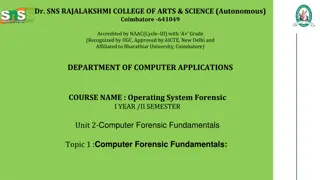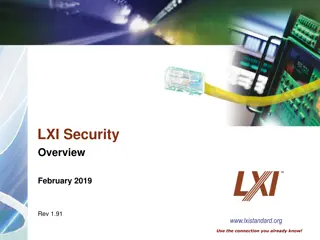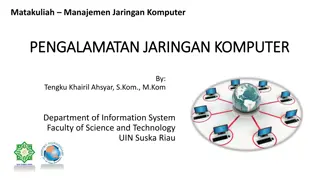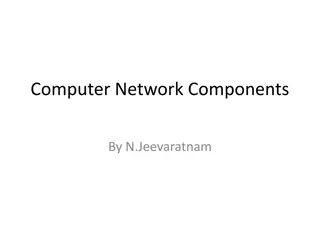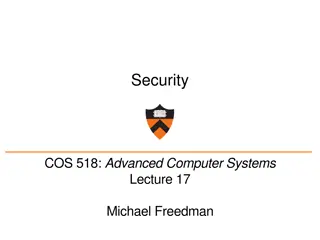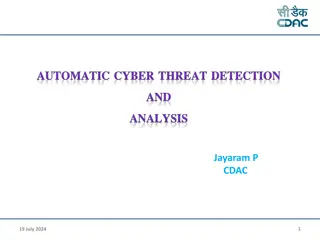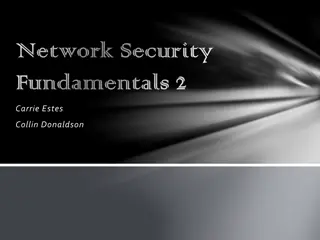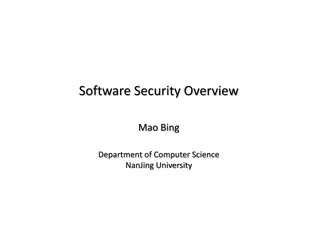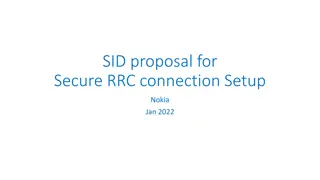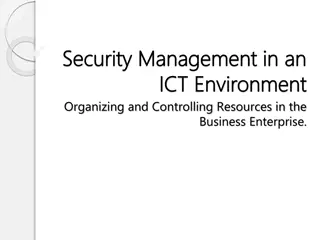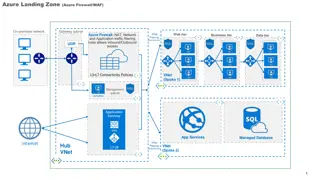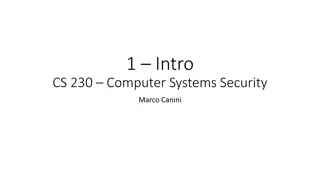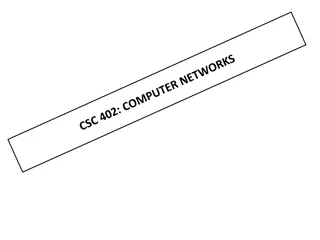Overview of Computer and Network Security Fundamentals
Computer and network systems provide opportunities for cost reduction, efficiency improvement, and revenue increase but also expose us to security risks. This lecture covers encryption, authentication, security services, threats, and countermeasures related to network and computer security. It emphasizes the importance of protecting assets and information from cyber attacks through prevention, detection, and response measures.
Download Presentation

Please find below an Image/Link to download the presentation.
The content on the website is provided AS IS for your information and personal use only. It may not be sold, licensed, or shared on other websites without obtaining consent from the author. Download presentation by click this link. If you encounter any issues during the download, it is possible that the publisher has removed the file from their server.
E N D
Presentation Transcript
CSC 418: COMPUTER SECURITY LECTURE NOTE DR. (MRS) K. A. OLATUNJI
COURSE CONTENT Introduction to security in the context of information system and networks: Fundamentals of encryption technology; cryptography, secret key algorithms; public-key algorithms; authentication protocol; digital signatures; Systems and protocols for providing security services including e-mail, internet protocol security and web security; Threats to network and computer security and countermeasures including intrusion detection, virus counter measures, access control and firewall.
OVERVIEW OF COMPUTER AND NETWORK SECURITY Computer and network systems have given us unlimited opportunities to reduce costs, improve efficiency, and increase revenues, as demonstrated by an expanding number of computer and network applications. Unfortunately, our dependence on computer and network systems has also exposed us to new risks which threaten the security of computer and network systems and present new challenges for protecting our assets and information on computer and network systems.
Computer and network technologies have empowered us and transformed our business and life in many ways. However, our increasing dependence on computer and network systems has also exposed us to a wide range of cyber security risks involving system vulnerabilities and threats to our assets and transactions on those systems. Computer and network security is concerned with availability, confidentiality, integrity, non-repudiation, trust, and many other aspects of computer and network assets which may be compromised by cyber attacks from external and insider threats through exploiting system vulnerabilities. The protection of computer and network security must cover prevention to reduce system vulnerabilities, detection to identify ongoing cyber attacks that break through prevention mechanisms, and response to stop and control cyber attacks, recover systems and correct exploited system vulnerabilities.
The field of network and Internet security consists of measures to deter, prevent, detect, and correct security violations that involve the transmission of information. Example of security violations: User A transmits a file to user B. The file contains sensitive information (e.g., payroll records) that is to be protected from disclosure. User C, who is not authorized to read the file, is able to monitor the transmission and capture a copy of the file during its transmission.
A network manager, D, transmits a message to a computer, E, under its management. The message instructs computer E to update an authorization file to include the identities of a number of new users who are to be given access to that computer. User F intercepts the message, alters its contents to add or delete entries, and then forwards the message to computer E, which accepts the message as coming from manager D and updates its authorization file accordingly.
Rather than intercept a message, user F constructs its own message with the desired entries and transmits that message to computer E as if it had come from manager D. Computer E accepts the message as coming from manager D and updates its authorization file accordingly. A message is sent from a customer to a stockbroker with instructions for various transactions. Subsequently, the investments lose value and the customer denies sending the message.
An employee is fired without warning. The personnel manager sends a message to a server system to invalidate the employee s account. When the invalidation is accomplished, the server is to post a notice to the employee s file as confirmation of the action. The employee is able to intercept the message and delay it long enough to make a final access to the server to retrieve sensitive information. The message is then forwarded, the action taken, and the confirmation posted. The employee s action may go unnoticed for some considerable time.
What is computer security? Computer Security: is the protection afforded to an automated information system in order to attain the applicable objectives of preserving the integrity, availability, and confidentiality of information system resources (such as hardware, software, firmware, information/data, and telecommunications). This definition introduces three key objectives that are at the heart of computer security: 1.Confidentiality: this is preserving authorized restrictions on information access and disclosure, including means for protecting personal privacy and proprietary information. A loss of confidentiality is the unauthorized disclosure of information.
This term covers two related concepts: Data confidentiality: Assures that private or confidential information is not made available or disclosed to unauthorized individuals. Privacy: Assures that individuals control or influence what information related to them may be collected and stored and by whom and to whom that information may be disclosed.
2.Integrity: this is guarding against improper information modification or destruction, including ensuring information nonrepudiation and authenticity. A loss of integrity is the unauthorized modification or destruction of information. This term covers two related concepts: Data integrity: Assures that information and programs are changed only in a specified and authorized manner. System integrity: Assures that a system performs its intended function in an unimpaired manner, free from deliberate or inadvertent unauthorized manipulation of the system.
3.Availability: this deal with ensuring timely and reliable access to and use of information. A loss of availability is the disruption of access to or use of information or an information system. Availability assures that systems work promptly and service is not denied to authorized users. These three concepts embody the fundamental security objectives for both data and for information and computing services. There are other concepts and they are discussed as follows
Authenticity: This is the property of being genuine and being able to be verified and trusted; confidence in the validity of a transmission, a message, or message originator. This means verifying that users are who they say they are and that each input arriving at the system came from a trusted source. Accountability: The security goal that generates the requirement for actions of an entity to be traced uniquely to that entity. This supports nonrepudiation, deterrence, fault isolation, intrusion detection and prevention, and after-action recovery and legal action. Because truly secure systems are not yet an achievable goal, we must be able to trace a security breach to a responsible party. Systems must keep records of their activities to permit later forensic analysis to trace security breaches or to aid in transaction disputes.
Three levels of impact on organizations or individuals should there be a breach of security (i.e., a loss of confidentiality, integrity, or availability) are : Low, Moderate and High Low: The loss could be expected to have a limited adverse effect on organizational operations, organizational assets, or individuals. For example, the loss of confidentiality, integrity, or availability might (i) cause a degradation in mission capability to an extent and duration that the organization is able to perform its primary functions, but the effective - ness of the functions is noticeably reduced; (ii) result in minor damage to organizational assets; (iii) result in minor financial loss; or (iv) result in minor harm to individuals.
Moderate: The loss could be expected to have a serious adverse effect on organizational operations, organizational assets, or individuals. A serious adverse effect means that, for example, the loss might (i) cause a significant degradation in mission capability to an extent and duration that the organization is able to perform its primary functions, but the effectiveness of the functions is significantly reduced; (ii) result in significant damage to organizational assets; (iii) result in significant financial loss; or (iv) result in significant harm to individuals that does not involve loss of life or serious, life-threatening injuries.
High: The loss could be expected to have a severe or catastrophic adverse effect on organizational operations, organizational assets, or individuals. A severe or catastrophic adverse effect means that, for example, the loss might (i) cause a severe degradation in or loss of mission capability to an extent and duration that the organization is not able to perform one or more of its primary functions; (ii) result in major damage to organizational assets; (iii) Result in major financial loss; or (iv) result in severe or catastrophic harm to individuals involving loss of life or serious, life- threatening injuries.
Examples of the adverse effect in relation to confidentiality, integrity and availability: Confidentiality : Student grade information is an asset whose confidentiality is considered to be highly important by students. Grade information should only be available to students, their parents, and employees that require the information to do their job. Student enrollment information may have a moderate confidentiality rating. this information is seen by more people on a daily basis, is less likely to be targeted than grade information, and results in less damage if disclosed. Directory information, such as lists of students or faculty or departmental lists, may be assigned a low confidentiality rating or indeed no rating. This information is typically freely available to the public and published on a school s Web site.
Integrity: Patient allergy information is an example of an asset with a high requirement for integrity. The doctor should be able to trust that the information is correct and current. Now suppose that an employee (e.g., a nurse) who is authorized to view and update this information deliberately falsifies the data to cause harm to the hospital. The database needs to be restored to a trusted basis quickly, and it should be possible to trace the error back to the person responsible. Inaccurate information could result in serious harm or death to a patient and expose the hospital to massive liability.
An example of an asset that may be assigned a moderate level of integrity requirement is a Web site that offers a forum to registered users to discuss some specific topic. Either a registered user or a hacker could falsify some entries or deface the Web site. If the forum exists only for the enjoyment of the users, brings in little or no advertising revenue, and is not used for something important such as research, then potential damage is not severe. The Web master may experience some data, financial, and time loss.
An example of a low integrity requirement is an anonymous online poll. Many Web sites, such as news organizations, offer these polls to their users with very few safeguards. However, the inaccuracy and unscientific nature of such polls is well understood. Availability: The more critical a component or service, the higher is the level of availability required. Consider a system that provides authentication services for critical systems, applications, and devices. An interruption of service results in the inability for customers to access computing resources and staff to access the resources they need to perform critical tasks. The loss of the service translates into a large financial loss in lost employee productivity and potential customer loss.
An example of an asset that would typically be rated as having a moderate availability requirement is a public Web site for a university; the Web site provides information for current and prospective students and donors. Such a site is not a critical component of the university s information system, but its unavailability will cause some embarrassment. An online telephone directory lookup application would be classified as a low availability requirement. Although the temporary loss of the application may be an annoyance, there are other ways to access the information, such as a hardcopy directory or the operator.
The Challenges of Computer Security Computer and network security is both fascinating and complex. Some of the reasons follow: Security is not as simple as it might first appear to the novice. The requirements seem to be straightforward; indeed, most of the major requirements for security services can be given self- explanatory, one-word labels: confidentiality, authentication, nonrepudiation, or integrity. But the mechanisms used to meet those requirements can be quite complex, and understanding them may involve rather delicate reasoning.
In developing a particular security mechanism or algorithm, one must always consider potential attacks on those security features. In many cases, successful attacks are designed by looking at the problem in a completely different way, therefore exploiting an unexpected weakness in the mechanism. Having designed various security mechanisms, it is necessary to decide where to use them. This is true both in terms of physical placement (e.g., at what points in a network are certain security mechanisms needed) and in a logical sense (e.g., at what layer or layers of an architecture such as TCP/IP [Transmission Control Protocol/Internet Protocol] should mechanisms be placed).
Security mechanisms typically involve more than a particular algorithm or protocol. They also require that participants be in possession of some secret information (e.g., an encryption key), which raises questions about the creation, distribution, and protection of that secret information. There also may be a reliance on communications protocols whose behavior may complicate the task of developing the security mechanism. Security requires regular, even constant, monitoring, and this is difficult in today s short- term, overloaded environment.
Computer and network security is essentially a battle of wits between a perpetrator who tries to find holes and the designer or administrator who tries to close them. The great advantage that the attacker has is that he or she need only find a single weakness, while the designer must find and eliminate all weaknesses to achieve perfect security. Many users and even security administrators view strong security as an impediment to efficient and user-friendly operation of an information system or use of information.
The OSI security architecture The International Telecommunication Union (ITU) Telecommunication Standardization Sector (ITU-T) is a United Nations-sponsored agency that develops standards, called Recommendations, relating to telecommunications and to open systems interconnection (OSI). The OSI security architecture is useful to managers as a way of organizing the task of providing security. Furthermore, because this architecture was developed as an international standard, computer and communications vendors have developed security features for their products and services that relate to this structured definition of services and mechanisms.
The OSI security architecture focuses on security attacks, mechanisms, and services. Security attack: Any action that compromises the security of information owned by an organization. Security mechanism: A process (or a device incorporating such a process) that is designed to detect, prevent, or recover from a security attack. Security service: A processing or communication service that enhances the security of the data processing systems and the information transfers of an organization. The services are intended to counter security attacks, and they make use of one or more security mechanisms to provide the service.
Threat: A potential for violation of security, which exists when there is a circumstance, capability, action, or event that could breach security and cause harm. That is, a threat is a possible danger that might exploit a vulnerability. Attack : An assault on system security that derives from an intelligent threat; that is, an intelligent act that is a deliberate attempt (especially in the sense of a method or technique) to evade security services and violate the security policy of a system.
Security Attack: are classified into two namely; Passive attack and active attack A passive attack: attempts to learn or make use of information from the system but does not affect system resources. An active attack: attempts to alter system resources or affect their operation.
Passive attacks are in the nature of eavesdropping on, or monitoring of transmissions. The goal of the opponent is to obtain information that is being transmitted. Two types of passive attacks are the release of message contents and traffic analysis.
The release of message contents is easily understood. For example, A telephone conversation, an electronic mail message, and a transferred file may contain sensitive or confidential information. There must be a prevention of an opponent from learning the contents of these transmissions. A second type of passive attack, traffic analysis, is subtler. Suppose there is a way of masking the contents of messages or other information traffic so that opponents, even if they captured the message, could not extract the information from the message.
The common technique for masking contents is encryption. If encryption protection is in place, an opponent might still be able to observe the pattern of these messages. The opponent could determine the location and identity of communicating hosts and could observe the frequency and length of messages being exchanged. This information might be useful in guessing the nature of the communication that was taking place.
Passive attacks are very difficult to detect, because they do not involve any alteration of the data. The message traffic is sent and received in an apparently normal fashion, and neither the sender nor receiver is aware that a third party has read the messages or observed the traffic pattern. Encryption is the only means that is feasible to prevent the success of these attacks. Thus, the emphasis in dealing with passive attacks is on prevention rather than detection.
Active attacks involve some modification of the data stream or the creation of a false stream and can be subdivided into four categories: masquerade, replay, modification of messages, and denial of service.
A masquerade takes place when one entity pretends to be a different entity (path 2 of Figure b is active) A masquerade attack usually includes one of the other forms of active attack. For example, authentication sequences can be captured and replayed after a valid authentication sequence has taken place, thus enabling an authorized entity with few privileges to obtain extra privileges by impersonating an entity that has those privileges.
Replay involves the passive capture of a data unit and its subsequent retransmission to produce an unauthorized effect. (paths 1, 2, and 3 active) Modification of messages simply means that some portion of a legitimate message is altered, or that messages are delayed or reordered, to produce an unauthorized effect. (paths 1 and 2 active) For example, a message meaning Allow Davis Nkiru to read confidential file accounts is modified to mean Allow Ola Sam to read confidential file accounts.
The denial of service prevents or inhibits the normal use or management of communications facilities (path 3 active). This attack may have a specific target; for example, an entity may suppress all messages directed to a particular destination (e.g., the security audit service). Another form of service denial is the disruption of an entire network, either by disabling the network or by overloading it with messages so as to degrade performance.
Active attacks present the opposite characteristics of passive attacks. Passive attacks are difficult to detect, but measures are available to prevent their success. On the other hand, it is quite difficult to prevent active attacks absolutely because of the wide variety of potential physical, software, and network vulnerabilities. The goal is to detect active attacks and to recover from any disruption or delays caused by them. If the detection has a deterrent effect, it may also contribute to prevention.
Security Services A security service is a processing or communication service that is provided by a system to give a specific kind of protection to system resources; security services implement security policies and are implemented by security mechanisms. (By RFC 4949) A security service is a service that is provided by a protocol layer of communicating open systems and that ensures adequate security of the systems or of data transfers. (By X.800)
X.800 divides these services into five categories and fourteen specific services: AUTHENTICATION This is the assurance that the communicating entity is the one that it claims to be. For example, in the case of an ongoing interaction, such as the connection of a terminal to a host, two aspects are involved: First, at the time of connection initiation, the service assures that the two entities are authentic, that is, that each is the entity that it claims to be. Second, the service must assure that the connection is not interfered with in such a way that a third party can masquerade as one of the two legitimate parties for the purposes of unauthorized transmission or reception.
Two services of authentication are: Peer Entity Authentication Used in association with a logical connection to provide confidence in the identity of the entities connected. Two entities are considered peers if they implement to same protocol in different systems; for example two TCP modules in two communicating systems. Peer entity authentication is provided for use at the establishment of, or at times during the data transfer phase of, a connection. It attempts to provide confidence that an entity is not performing either a masquerade or an unauthorized replay of a previous connection.
Data-Origin Authentication In a connectionless transfer, it provides assurance that the source of received data is as claimed. Provides for the corroboration of the source of a data unit. It does not provide protection against the duplication or modification of data units. This type of service supports applications like electronic mail, where there are no prior interactions between the communicating entities.
ACCESS CONTROL The prevention of unauthorized use of a resource (i.e., this service controls who can have access to a resource, under what conditions access can occur, and what those accessing the resource are allowed to do). Access control is the ability to limit and control the access to host systems and applications via communications links. To achieve this, each entity trying to gain access must first be identified, or authenticated, so that access rights can be tailored to the individual.
Data Confidentiality Confidentiality is the protection of transmitted data from passive attacks. For example, when a TCP connection is set up between two systems, this broad protection prevents the release of any user data transmitted over the TCP connection. The other aspect of confidentiality is the protection of traffic flow from analysis. This requires that an attacker not be able to observe the source and destination, frequency, length, or other characteristics of the traffic on a communications facility.
Connection Confidentiality The protection of all user data on a connection. Connectionless Confidentiality The protection of all user data in a single data block Selective-Field Confidentiality The confidentiality of selected fields within the user data on a connection or in a single data block. Traffic-Flow Confidentiality The protection of the information that might be derived from observation of traffic flows.
DATA INTEGRITY The assurance that data received are exactly as sent by an authorized entity (i.e., contain no modification, insertion, deletion, or replay). As with confidentiality, integrity can apply to a stream of messages, a single message, or selected fields within a message There are two types of data integrity service: Connection oriented integrity service and connectionless oriented integrity service.
A connection-oriented integrity service, is the service that deals with a stream of messages, assures that messages are received as sent with no duplication, insertion, modification, reordering, or replays. The connection-oriented integrity service addresses both message stream modification and denial of service. It is classified into two: service with or without recovery
Connection Integrity with Recovery Provides for the integrity of all user data on a connection and detects any modification, insertion, deletion, or replay of any data within an entire data sequence, with recovery attempted. Connection Integrity without Recovery As above, but provides only detection without recovery. Selective-Field Connection Integrity Provides for the integrity of selected fields within the user data of a data block transferred over a connection and takes the form of determination of whether the selected fields have been modified, inserted, deleted, or replayed.
Connectionless Integrity Provides for the integrity of a single connectionless data block and may take the form of detection of data modification. Additionally, a limited form of replay detection may be provided. Selective-Field Connectionless Integrity Provides for the integrity of selected fields within a single connectionless data block; takes the form of determination of whether the selected fields have been modified.
NONREPUDIATION Provides protection against denial by one of the entities involved in a communication of having participated in all or part of the communication. Nonrepudiation prevents either sender or receiver from denying a transmitted message. Thus, when a message is sent, the receiver can prove that the alleged sender in fact sent the message. Similarly, when a message is received, the sender can prove that the alleged receiver in fact received the message. Nonrepudiation, Origin Proof that the message was sent by the specified party. Nonrepudiation, Destination Proof that the message was received by the specified party.









